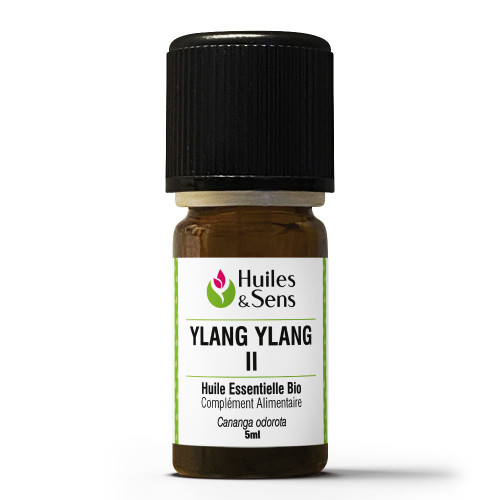Ylang Ylang essential oil II (organic)
Cananga odorata
Characteristics
Botanical name :
Cananga odorata
Production process :
Ylang Ylang II essential oil is obtained by steam distillation of the flowers of Cananga odorata (Lam.) Hook. f. et Thomson,forma genuina
Part of the plant used :
Flowers
Botanical family :
Annonaceae
Country of origin :
Madagascar, Comoros
Other names :
Kananga
Organoleptic characteristics :
- Odor: Floral, exotic, jasmine
- Appearance : Liquid which may become cloudy with time.
- Color : Pale yellow to orange
Principal biochemical components:
Germacrene D (10.00 to 28.00%)Trans trans alpha farnesene (5.00 to 18.00%)
Beta caryophyllene (7.00 to 17.00%)
Geranyl acetate (<= 12.00%)
Benzyl benzoate (<= 12.00%)
Linalool (<= 10.00%)
Allergens present : Benzyl benzoate (<= 12,00%), Linalool (<= 10,00%), Benzyl salicylate (<= 5,00%), Farnesol (<= 5,00%), Geraniol (<= 2,00%), Eugenol (<= 1,00%), Isoeugenol (<= 0,20%)
Packaging:
Brown glass bottle with codigout and child-resistant screw cap.
Storage :
Close bottle tightly after use. Store away from heat (below 20°C), air and light.
Recycling information / sorting instructions :
By following these instructions, you will contribute to the efficient and sustainable recycling of glass bottles of essential oils.
-
Empty the bottle completely: Make sure the bottle is completely empty before recycling. Essential oil residues can contaminate the recycling process.
-
Remove caps and droppers: Separate the different parts of the bottle. Caps and droppers, often made of plastic or metal, should be sorted separately in accordance with local regulations.
-
Rinse the bottle: Rinse the bottle to remove any residual essential oil. Use warm water and, if necessary, a little soap.
-
Local sorting instructions: Follow your local sorting instructions. In general, glass bottles should be placed in the glass recycling container. However, rules may vary, so check the guidelines of your local waste management service.
-
Labels: Paper labels may remain on the bottles, as they are usually disposed of during the glass recycling process.
Instructions for use
Main use :
Food supplement
Directions for use:
Read precautions before use. Up to 1 drop (0.03ml) per day diluted beforehand in a tablespoon of vegetable oil or honey.
Our commitments:
Culture: Organic, certified by Ecocert FR-BIO-01
Quality: Botanically and Biochemically Defined Essential Oil (BBDEO)
- 100% pure (free from other related essential oils),
- 100% natural (not denatured with synthetic molecules),
- 100% integral (not discolored, not deterpenated, not rectified...)
Precautions for use
Keep out of reach of children. Do not use during pregnancy, while breast-feeding or on children under 6. Do not use regularly. Do not use for prolonged periods (10 days maximum). Do not use undiluted. Never exceed recommended dosage. Ask your doctor or pharmacist for advice. This dietary supplement should be used as part of a varied, balanced diet and healthy lifestyle.
ATTENTION: Before using essential oils, please read the general precautions for use available in PDF below:
Download general precautions
Information on the use of essential oils in aromatherapy is provided for information purposes only, and in no way replaces advice and prescriptions issued by a doctor. Only a doctor is authorized to deliver the most appropriate therapeutic treatment. Algovital declines all responsibility in the event of accident, injury or damage suffered by anyone practicing self-medication on the basis of the information contained on this site.
16 other products in the same category:
Niaouli essential oil (organic)
Melaleuca quinquenervia
Juniper essential oil (organic)
Juniperus communis
Declination - 15 ml
Best before date : 09/30/2027











































